Love among the Inhabitants
Martha O'Kennon
Ella sings about the birds and the bees
Ella knew what she was talking about. And I bet she had never or almost never seen any pictures of the "act" as practised in the garden. On this page, I hope to gently introduce you to how this rite of passage takes place in Nature's Garden.
Here are three different kinds of beetles in the act. All of them are assuming the doggy position. The male is usually smaller and on top. First are lady beetles, then milkweed beetles, and finally Japanese beetles.
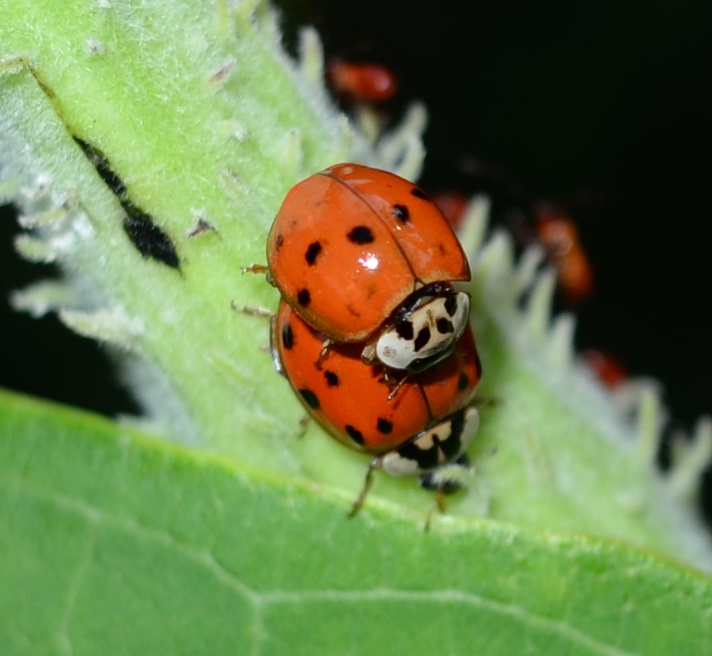
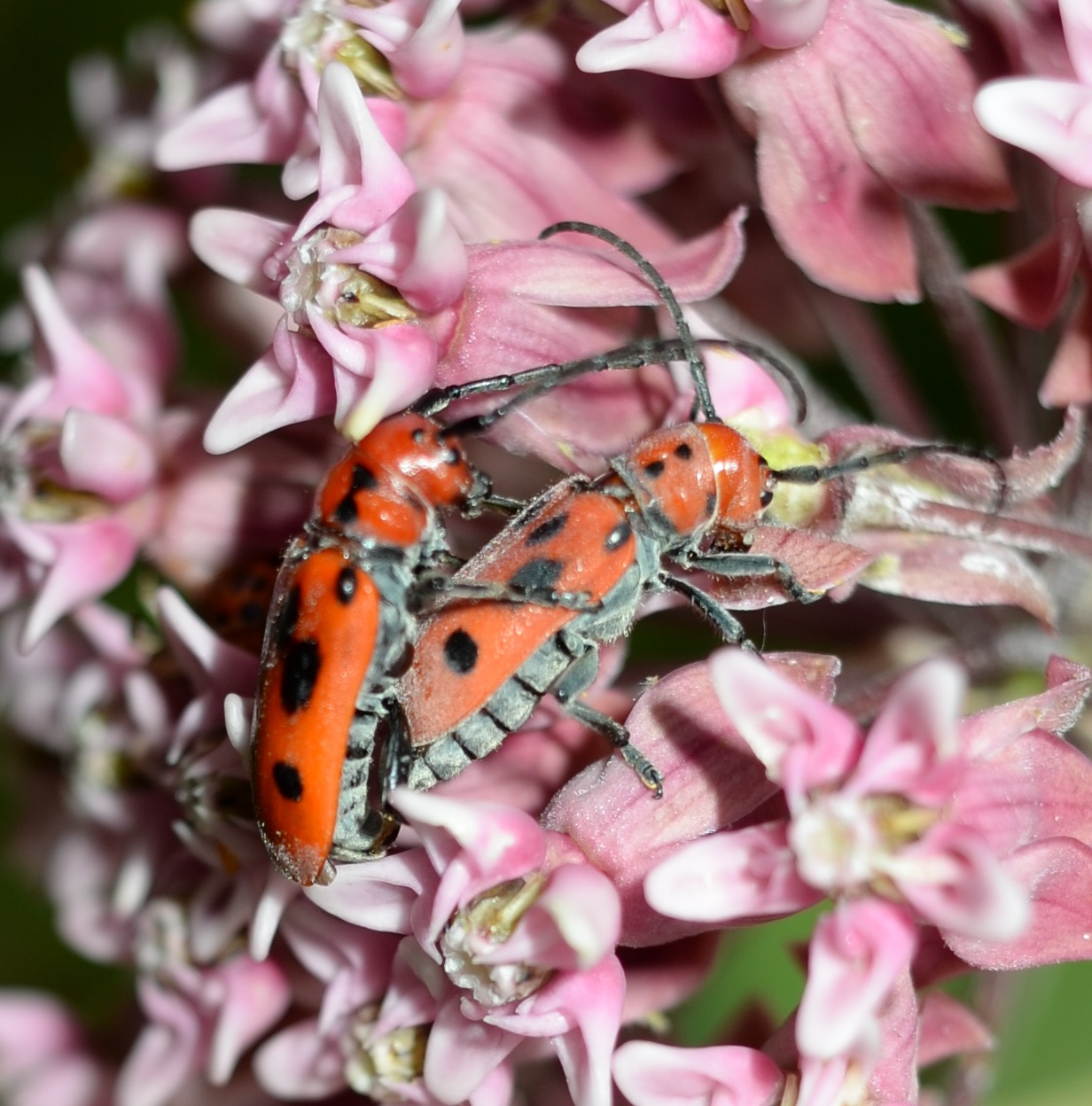

Here are three more beetles: the Locust Borer, who loves goldenrod to make love in. 2017 was a bumper year for Locust Borers in my yard and in other people's. The Lily Leaf beetle, though decked in classy colors, is hell on all kinds of lilies: daylilies, oriental lilies, and also tiger lilies. They will eat the leaves down to the stem. The lightning beetle is one kind of soldier beetle, but this kind is called the one-spotted soldier beetle because of the black spot on its red thorax.
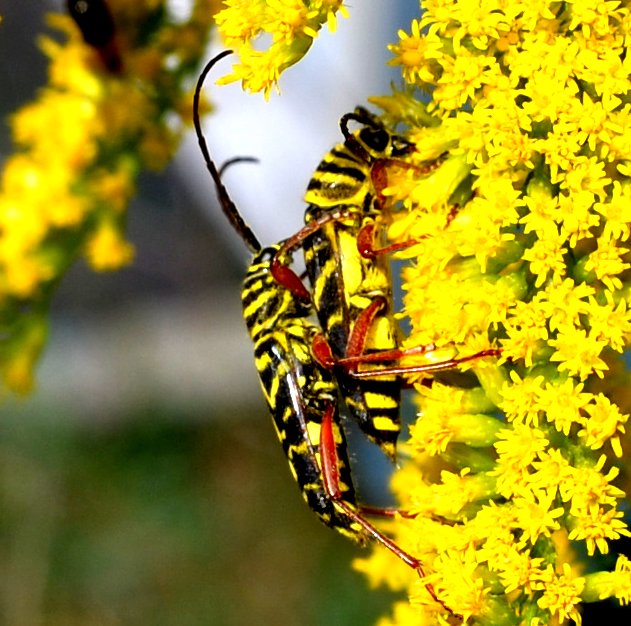
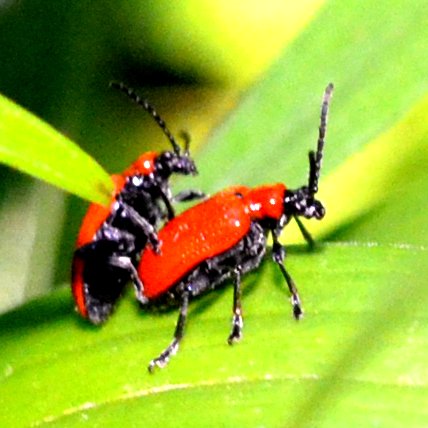
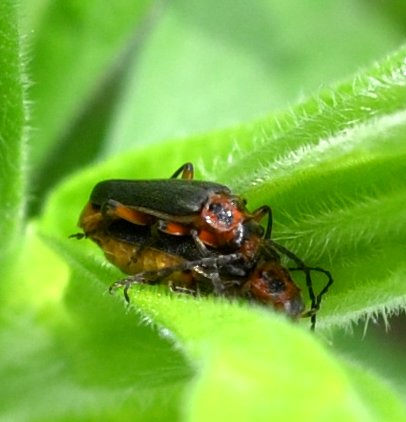
Bees do do it, but I only have one such picture. Maybe they are more modest than other critters. But we have many many kinds of "bugs". Here is one of my favorites: the Candy-Striped leafhopper. They have another MO for mating: End-to-end. I guess they don't want to really get to know each other. This is another popular method, and we will see it frequently among the other leafhoppers and other bugs. But just as I say that, here is another pair of leafhoppers back in position #1.
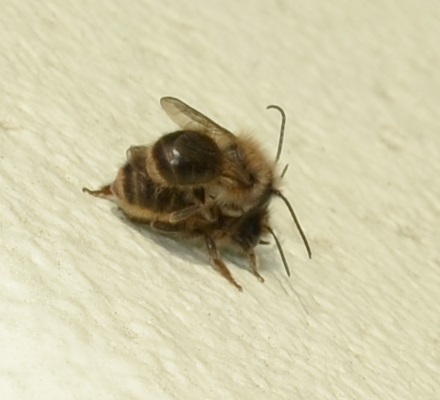
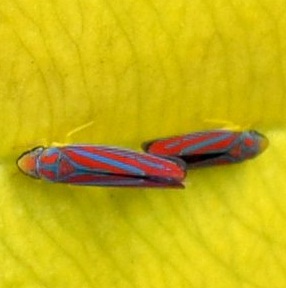
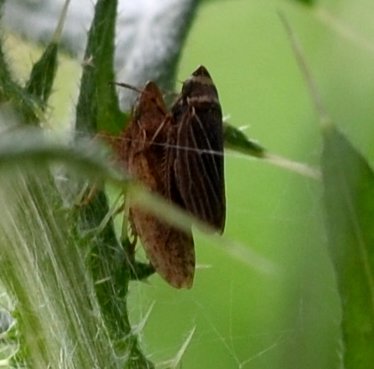
Another member of the bug order: a spittle-bug. They come in brown and black tones. I believe the browner is the female (not because of the color, but the size difference). They get this attractive name because their babies (nymphs) conceal themselves in a coat of froth. Next is a pair of Large Milkweed Bugs. And yes, even Earwigs do it.

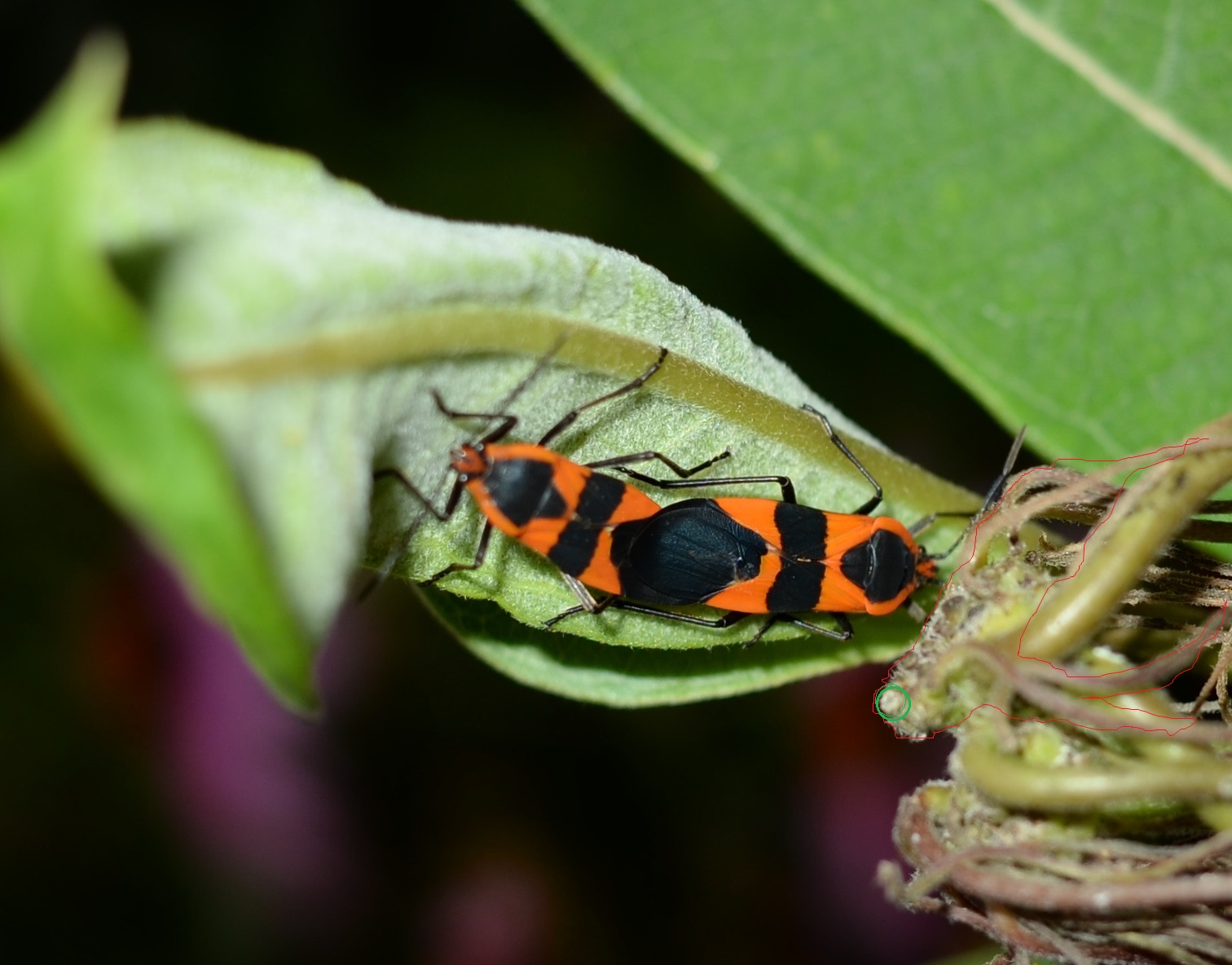
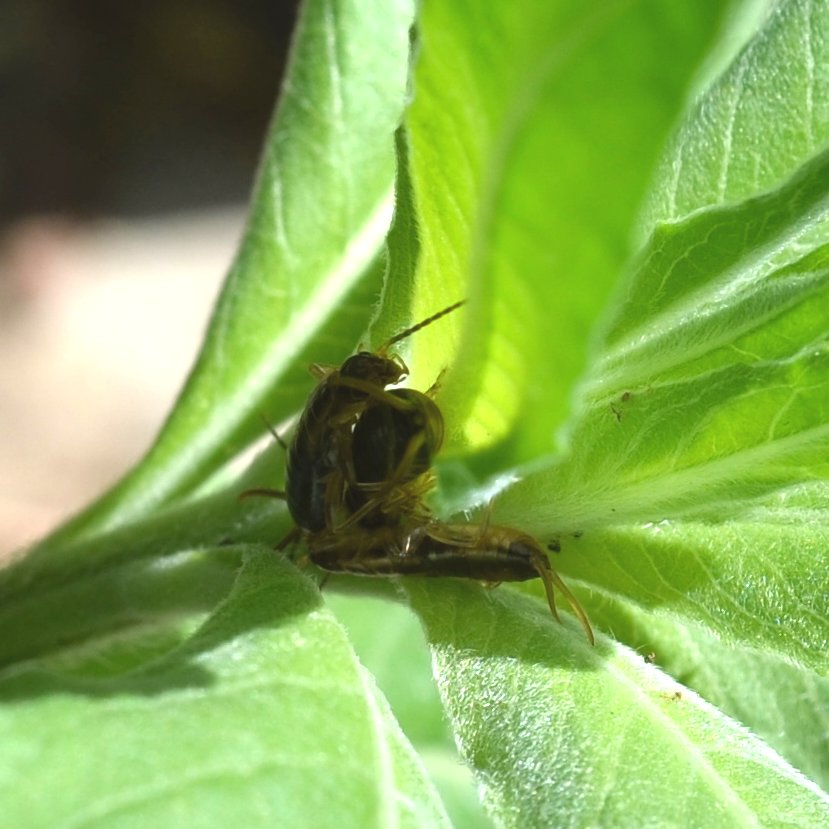
Here are a couple of photos of crane flies mating. (Crane flies are the big flies that look like mosquitoes but aren't.) In each of these two the larger female is hanging from a plant and the smaller male beneath her. I have been about to decide that the female is always up and the male down. But look at these midges: the male is the one with the fuzzy antennae!
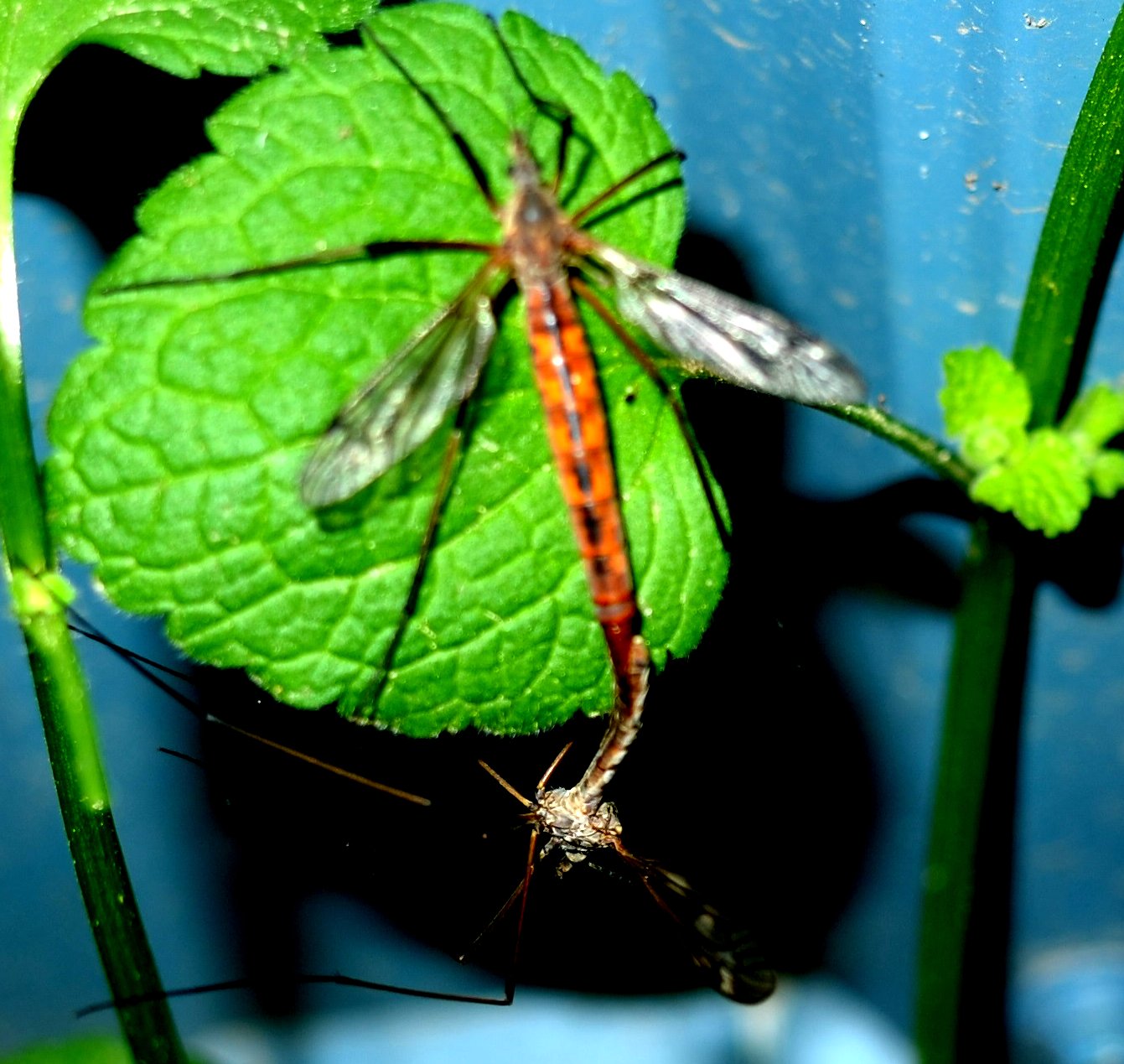
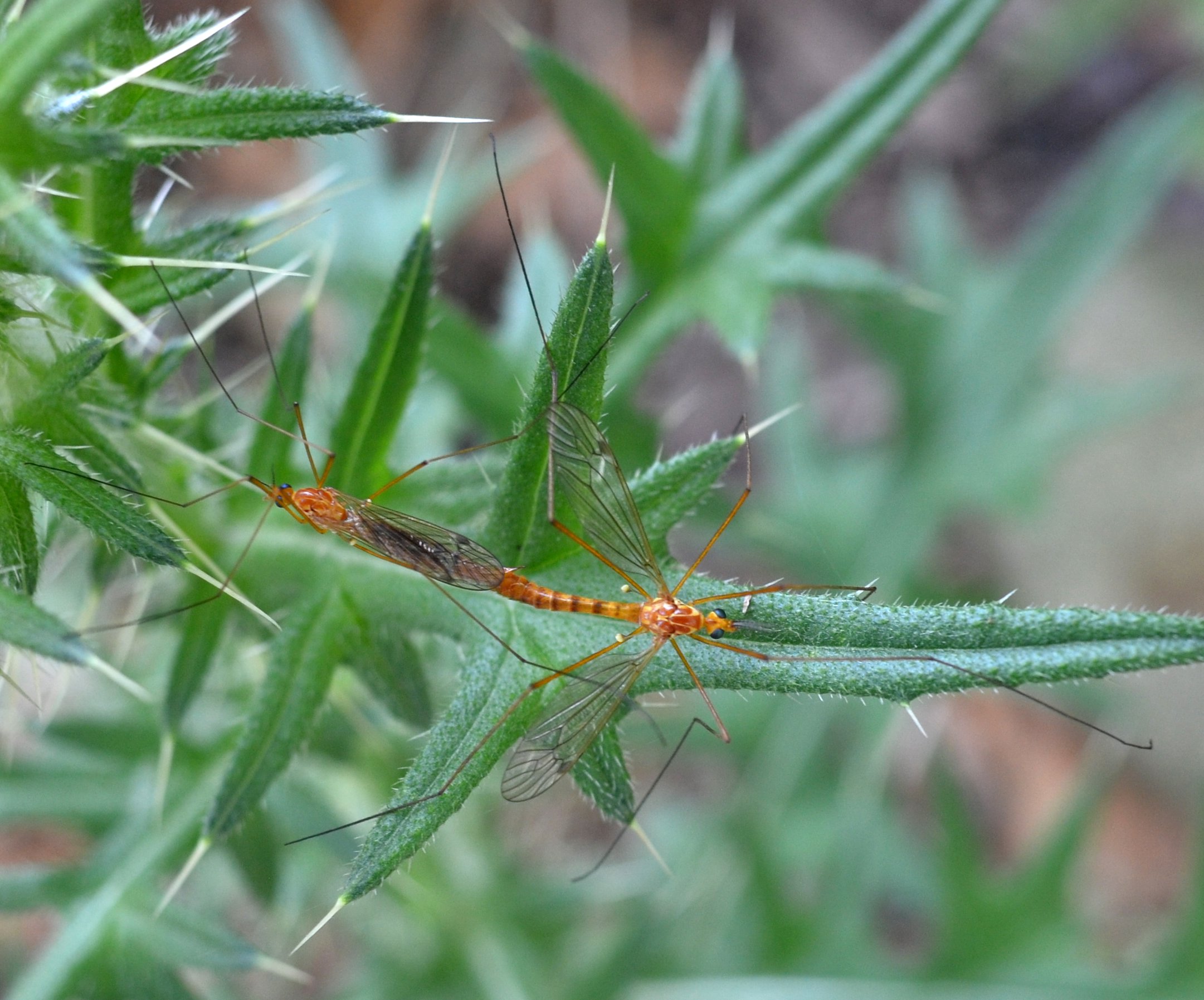
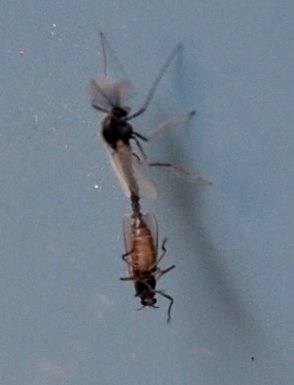
Here is a real treat for the hunter looking for something mysterious. The first two images (from April 10, 2015) show a huge red winged ant with two strange creatures that look like small wasps seemingly competing for the privilege of mating with her. The third frame is from April 1, 2017 and shows the female False Honey Ant after she has shed her wings and is about to go underground to lay her eggs.
 and two tiny males 4 10 17 3.jpg)
 and two tiny males 4 10 17 2.jpg)
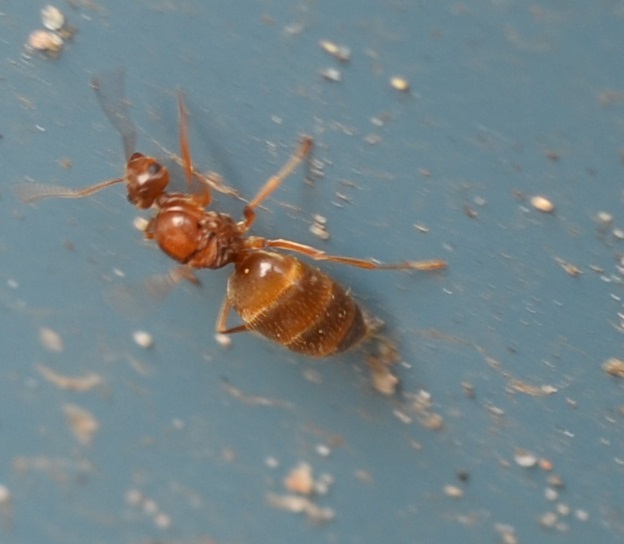
Here are two hover flies in the genus Toxomerus: T. marginatus and T. geminatus, back to the original position, and you can probably win if you bet on the upper fly as male. Doesn't the last image (another T. geminatus) make you want to go where no one has gone before?
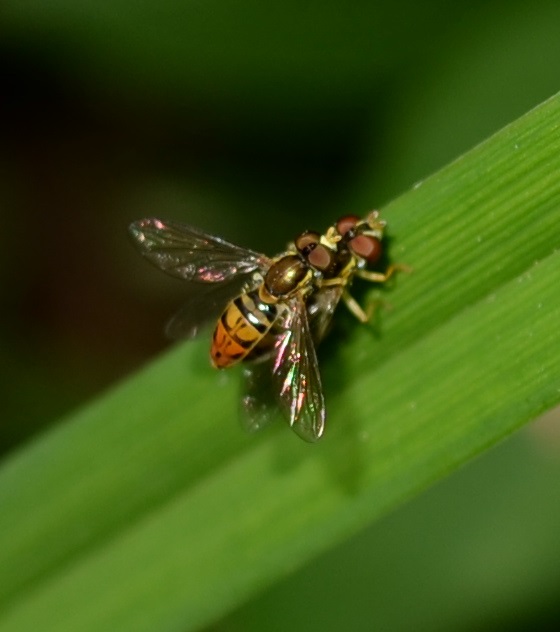

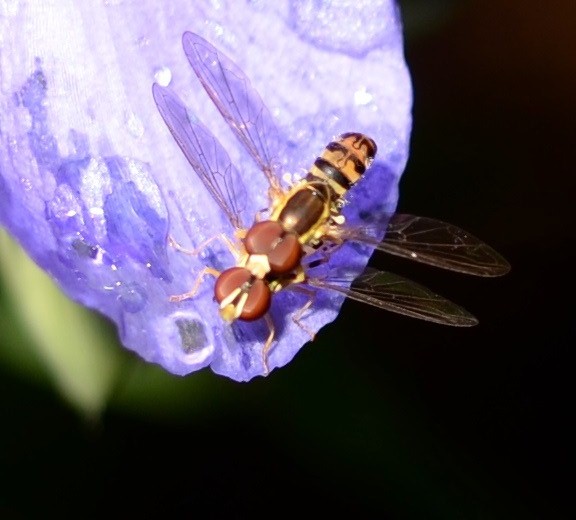
The scavenger flies do it and so do the other scavenger flies. In fact, sometimes they haven't quite sorted out who's who or how many.
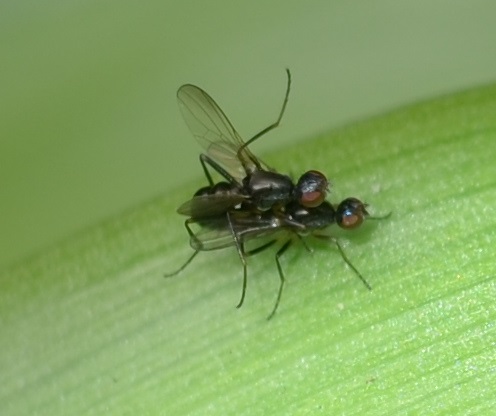
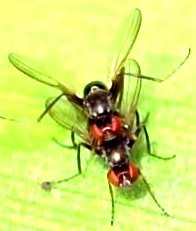

A male Gall Midge finds his true love and she gives consent. The March Flies do it for hours.
.jpg)
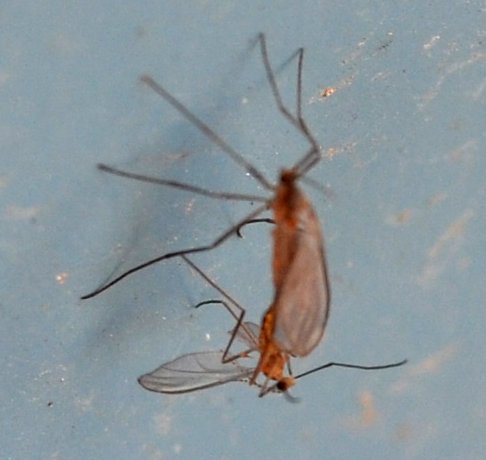
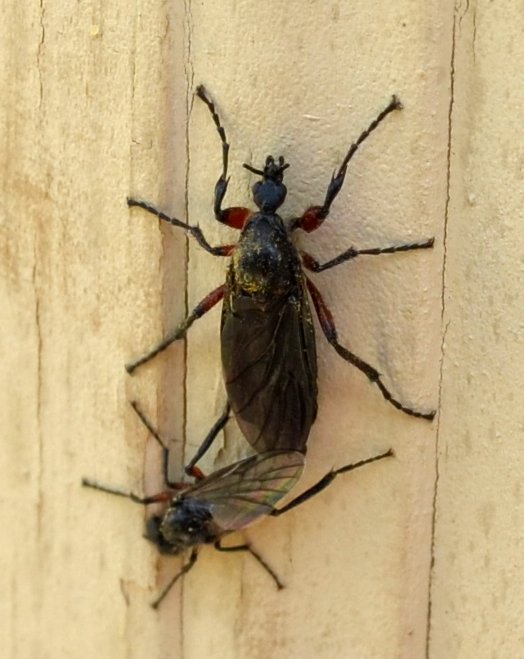
 and two tiny males 4 10 17 3.jpg)
 and two tiny males 4 10 17 2.jpg)

Yes, Barklice do it too. Here are a pair from genus Lachesilla, mating in Doggy position. Picture 3 shows a female Ectopsocus meridionalis laying eggs. These females are able to reproduce parthenogenetically - that is, no male is needed. Some Frogs are also able to do this.
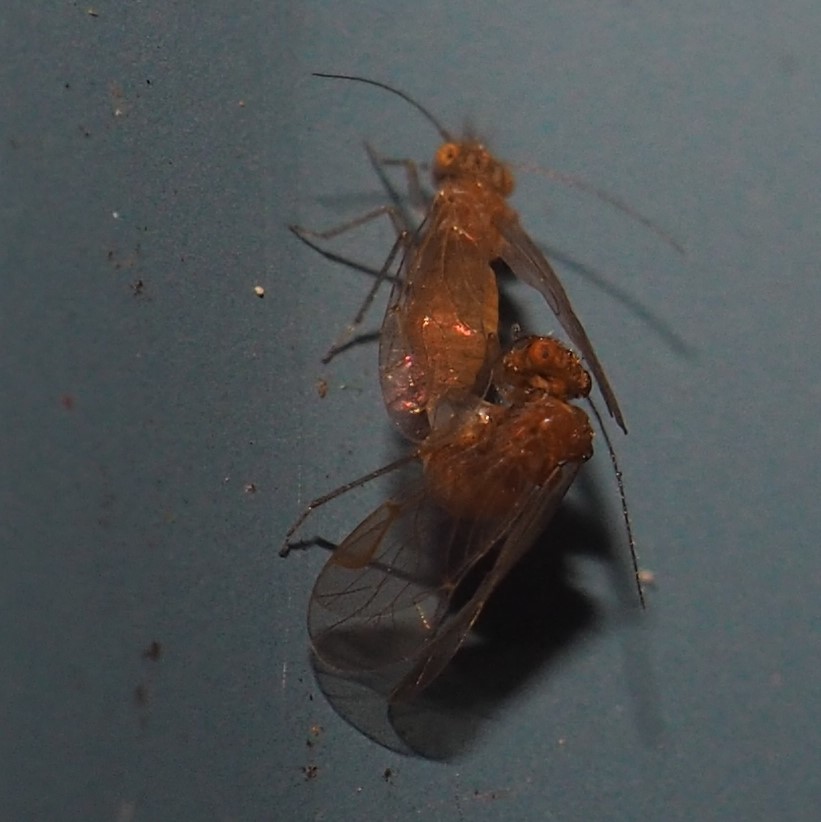
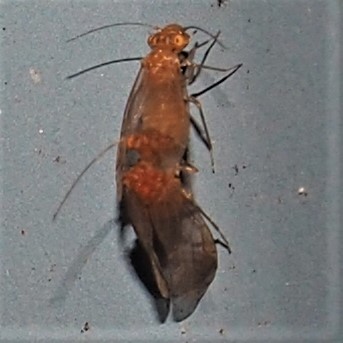
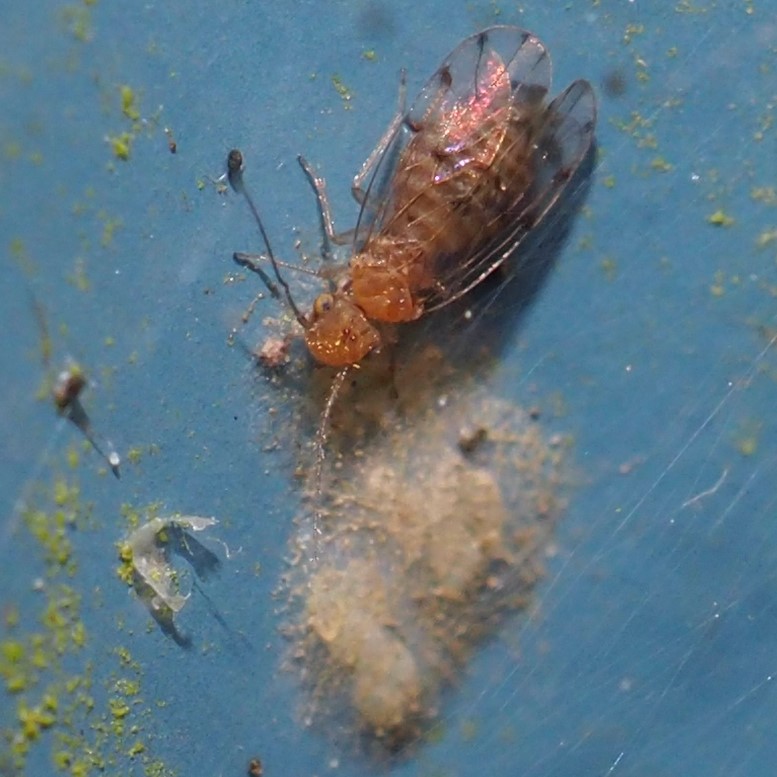
Here is a real treat for the hunter looking for something mysterious. The first two images (from April 10, 2015) show a huge red winged ant with two strange creatures that look like small wasps seemingly competing for the privilege of mating with her. The third frame is from April 1, 2017 and shows the female False Honey Ant after she has shed her wings and is about to go underground to lay her eggs.
 and two tiny males 4 10 17 3.jpg)
 and two tiny males 4 10 17 2.jpg)

Ichneumon wasps are willing to do it for love. Later she will use her long ovipositor to lay her eggs in dead wood. Why, I just
happen to have a stump from an old blue spruce tree that fell in 2007, yielding up a good ichneumon population. Last is a female ichneumon stabbing a twig case containing an unknown insect to get her eggs into it. Her babies just love other creatures' babies.
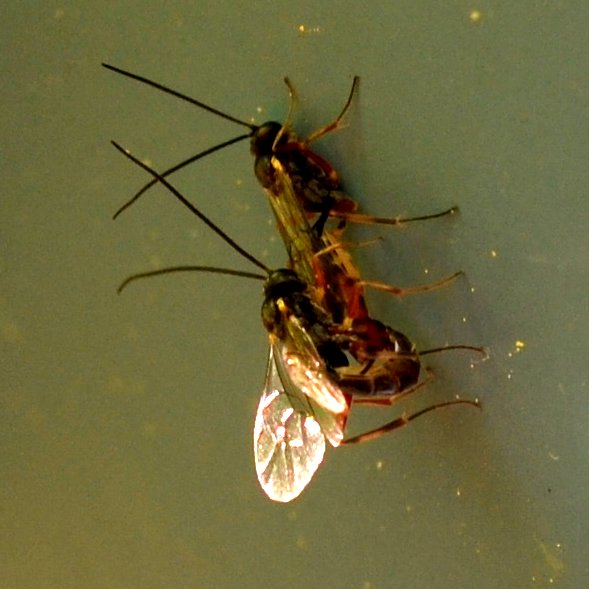


More extremes in ovipositors. Foreshadowing: wasps are not the only ones that use ovipositors to lay their eggs. If you think of an example, shhhhh! We'll come back to this! The ladies with the really really long ovipositors are called "gasterejections" or "gasteruptions". Asked to use this in a sentence, one student said: "I had a gasteruption when I saw that insect with the long ovipositor."
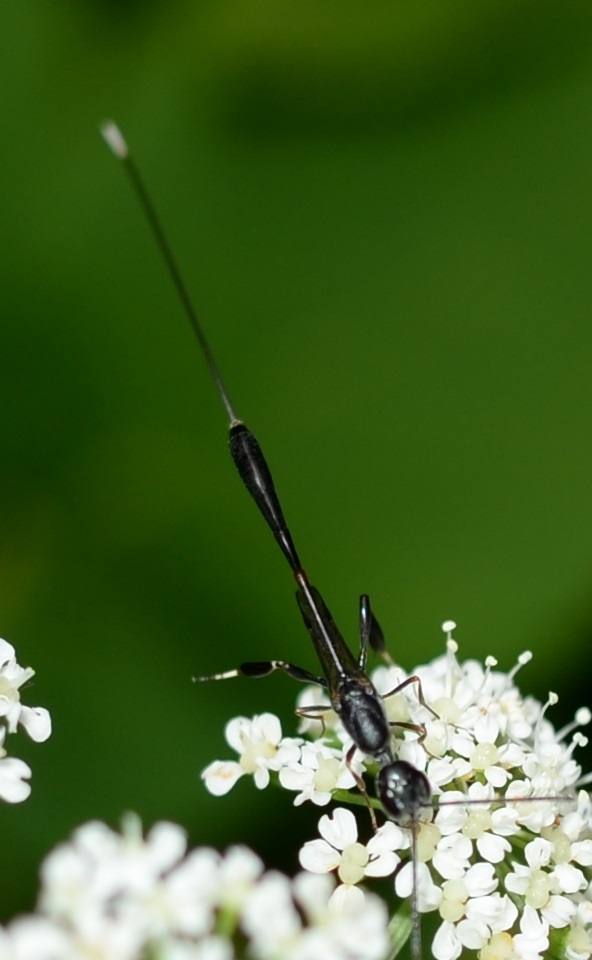

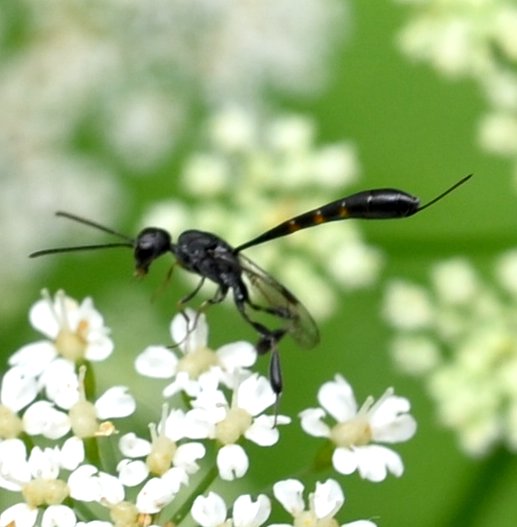
Use of an ovipositor is quite common in the Orthoptera (Grasshoppers, Katydids, and Crickets). Here are some images of females of each division. Here's the cricket woman with what looks like a sewing machine needle. Grasshoppers have more imaginative equipment for digging holes in hard material or for ovipositing like a katydid. (Go to google.com) and search for "grasshopper ovipositor" for a real ride through ovipositionland. All these eggs hatch into a tiny copy of the adult, as is usual for nymphs of creatures that have nymphs. This last image is that of a katydid nymph, fairly far along so that the "horsie" face of the adult face is clear and the long back springing legs are also well-formed.
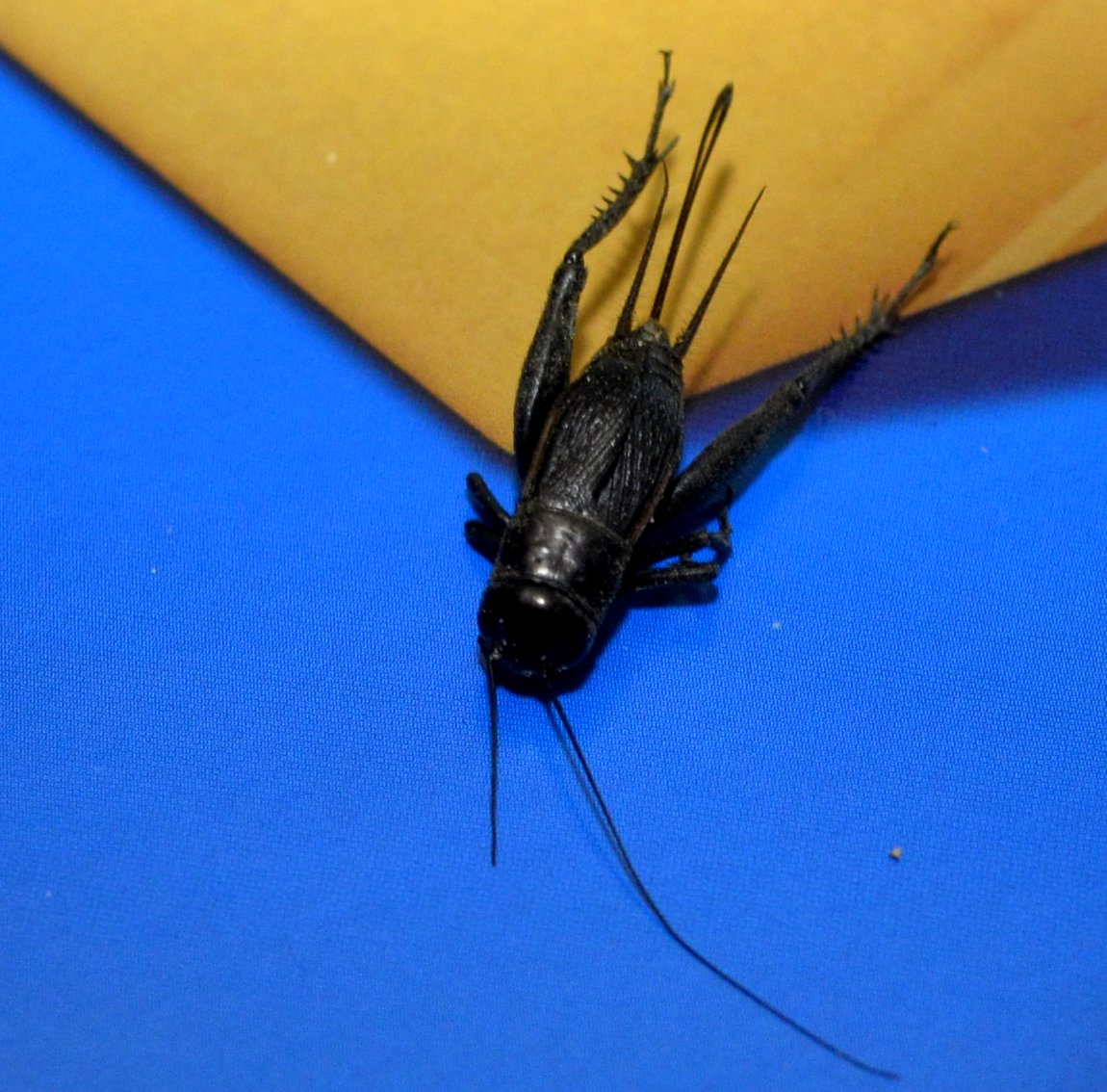
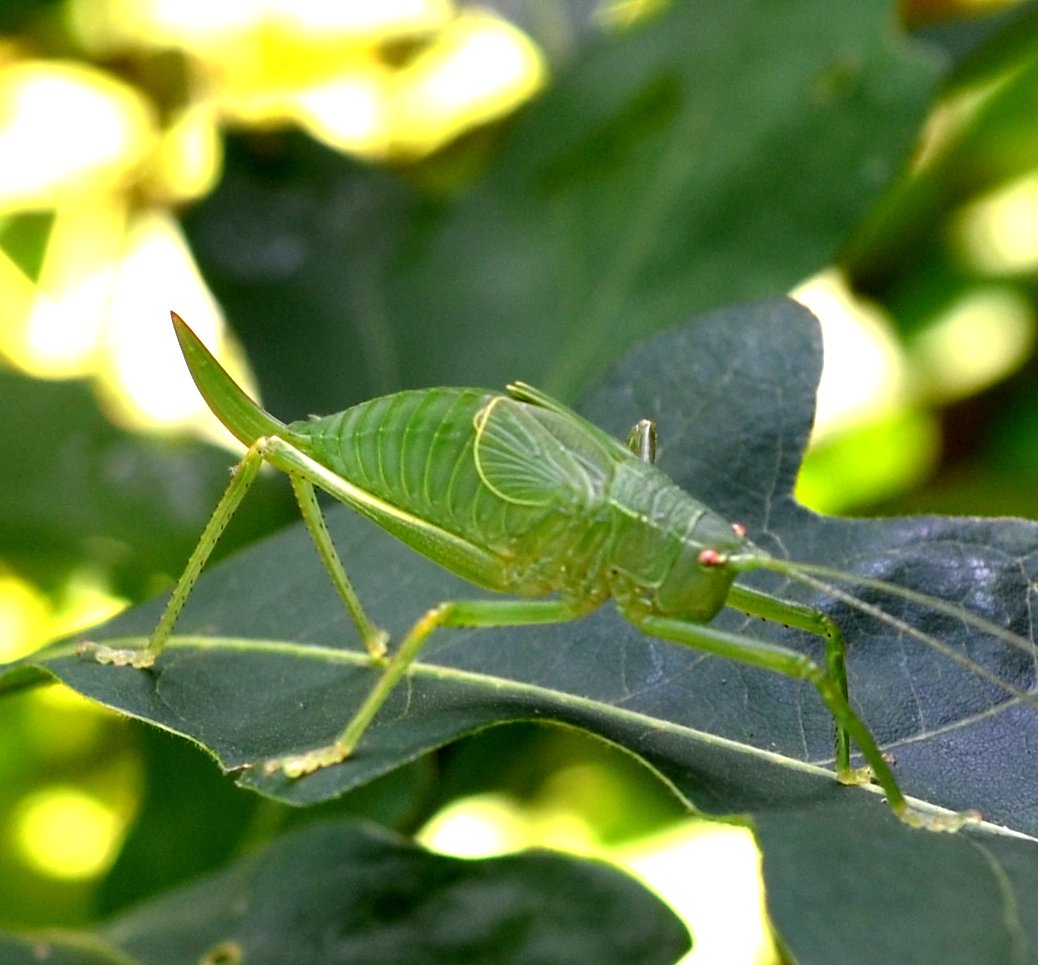
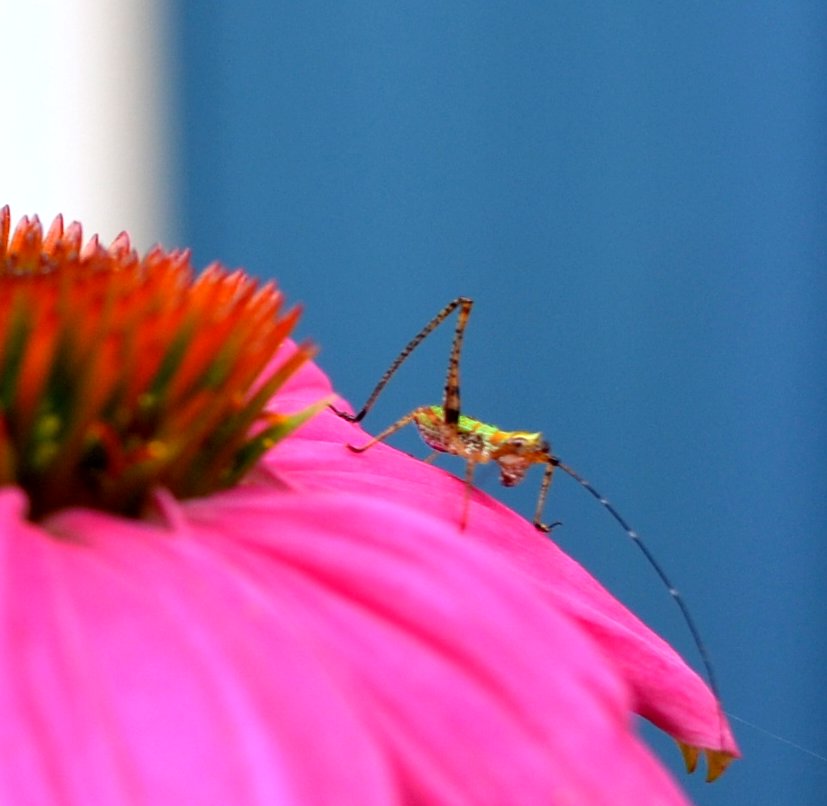
The mantids may or may not cannibalize their mates. But the nutrients in the male spider help the mother to produce healthier children. Here is the resultant egg case packed with eggs which turn into many many baby mantids. They are tiny copies of "baby mantids" and grow into larger and larger copies until they make their final moult and are adult mantids. So they belong to the egg--NYMPH-adult group, where NYMPH means the succession of babies that resemble each other.
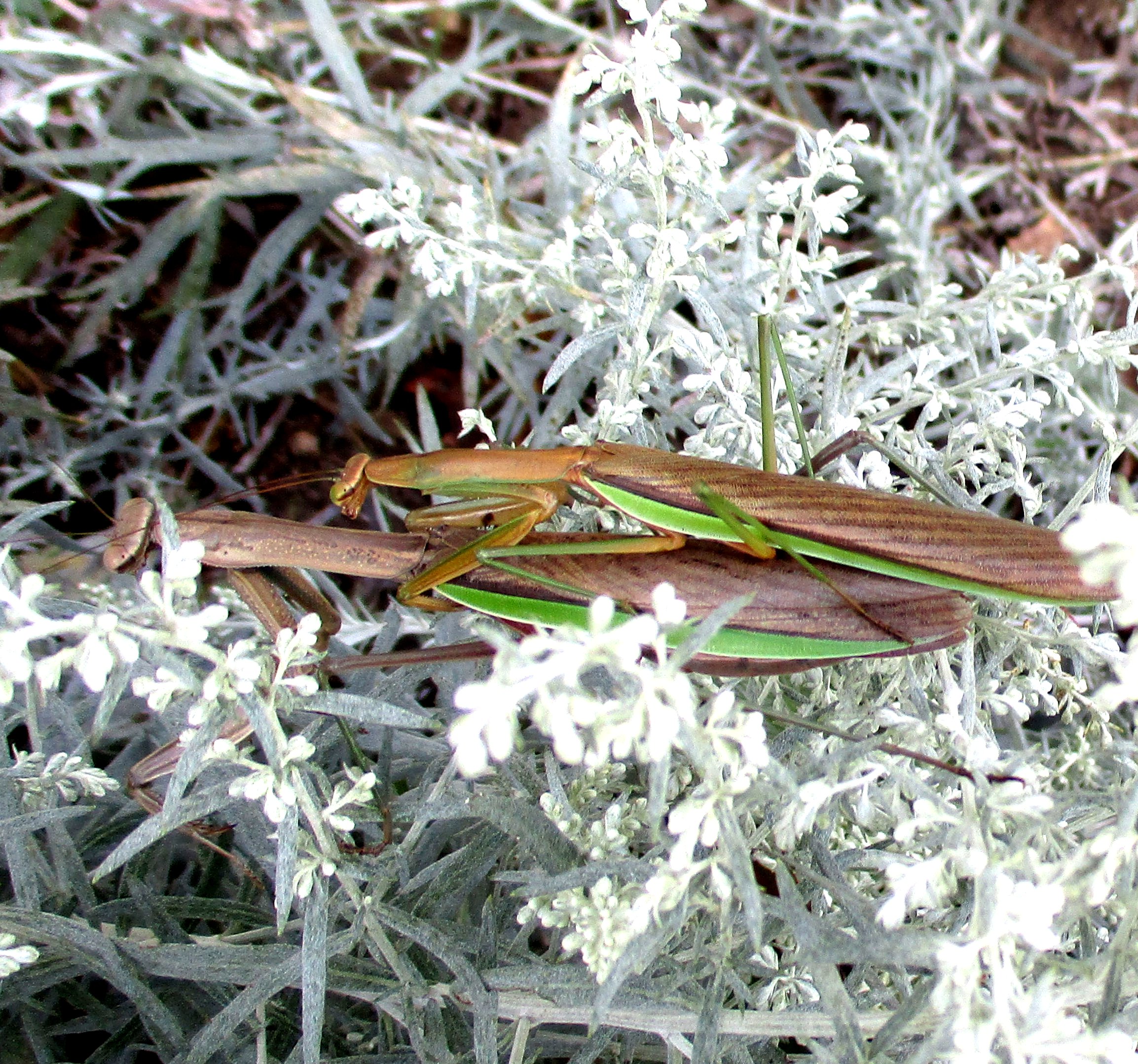
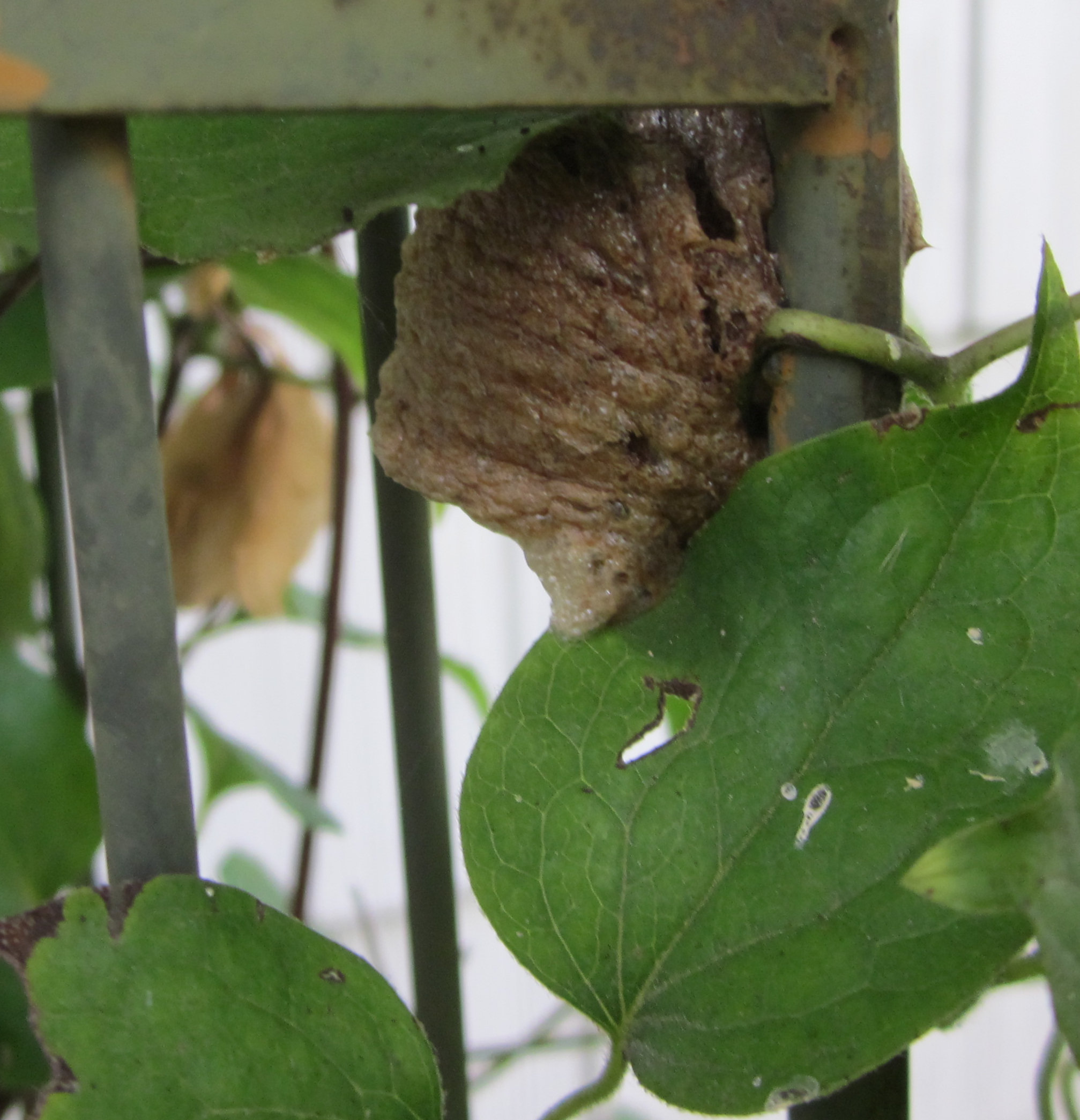
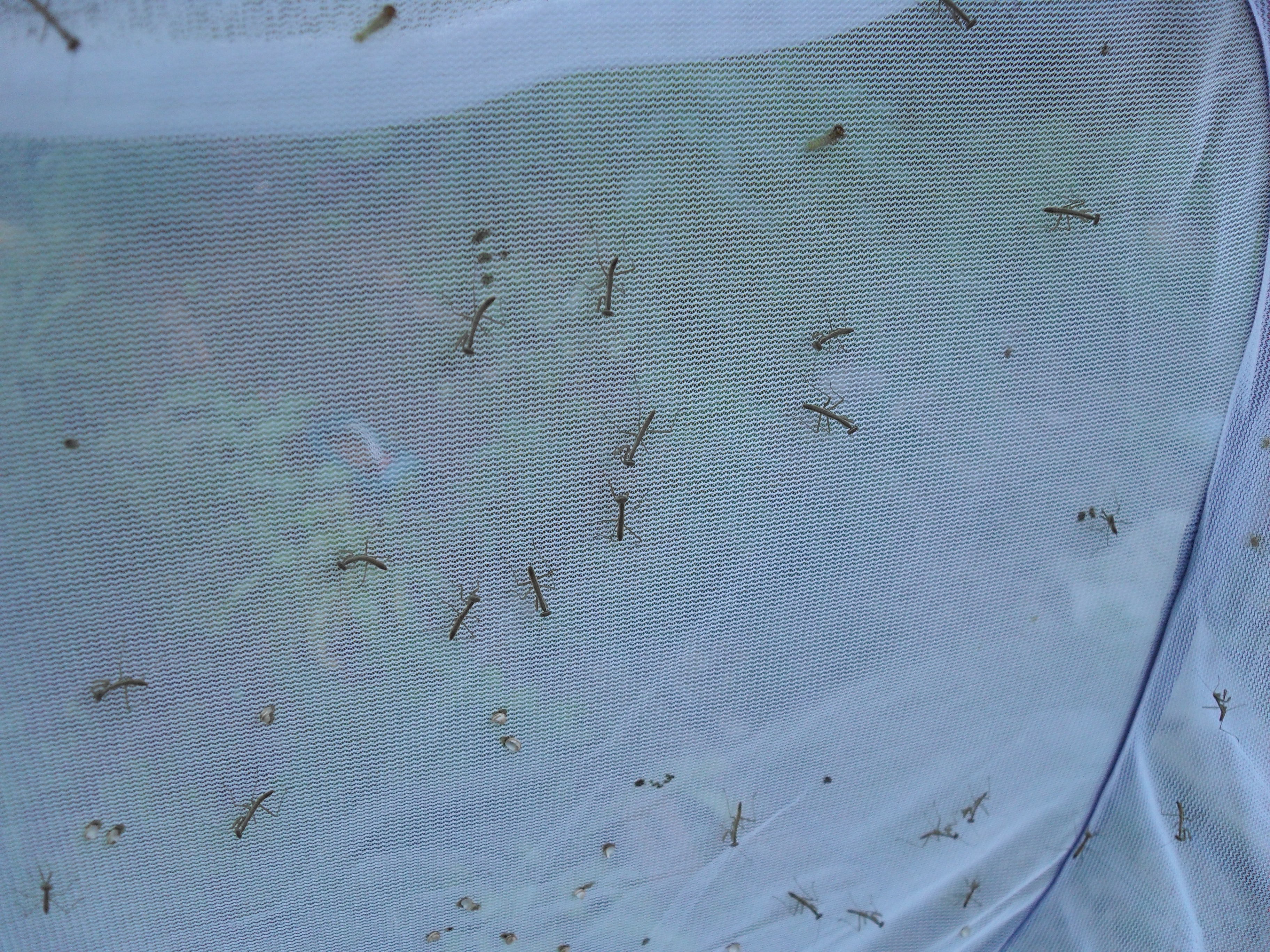
Moths do it: The incredibly beautiful Luna Moths included. We'll hear more about them when we talk about mimicry... This pair of Lunas will mate for ~20 hours, and then the female will lay her tiny eggs, which love to devour walnut leaves. This third image is of a very young larva (caterpillar).
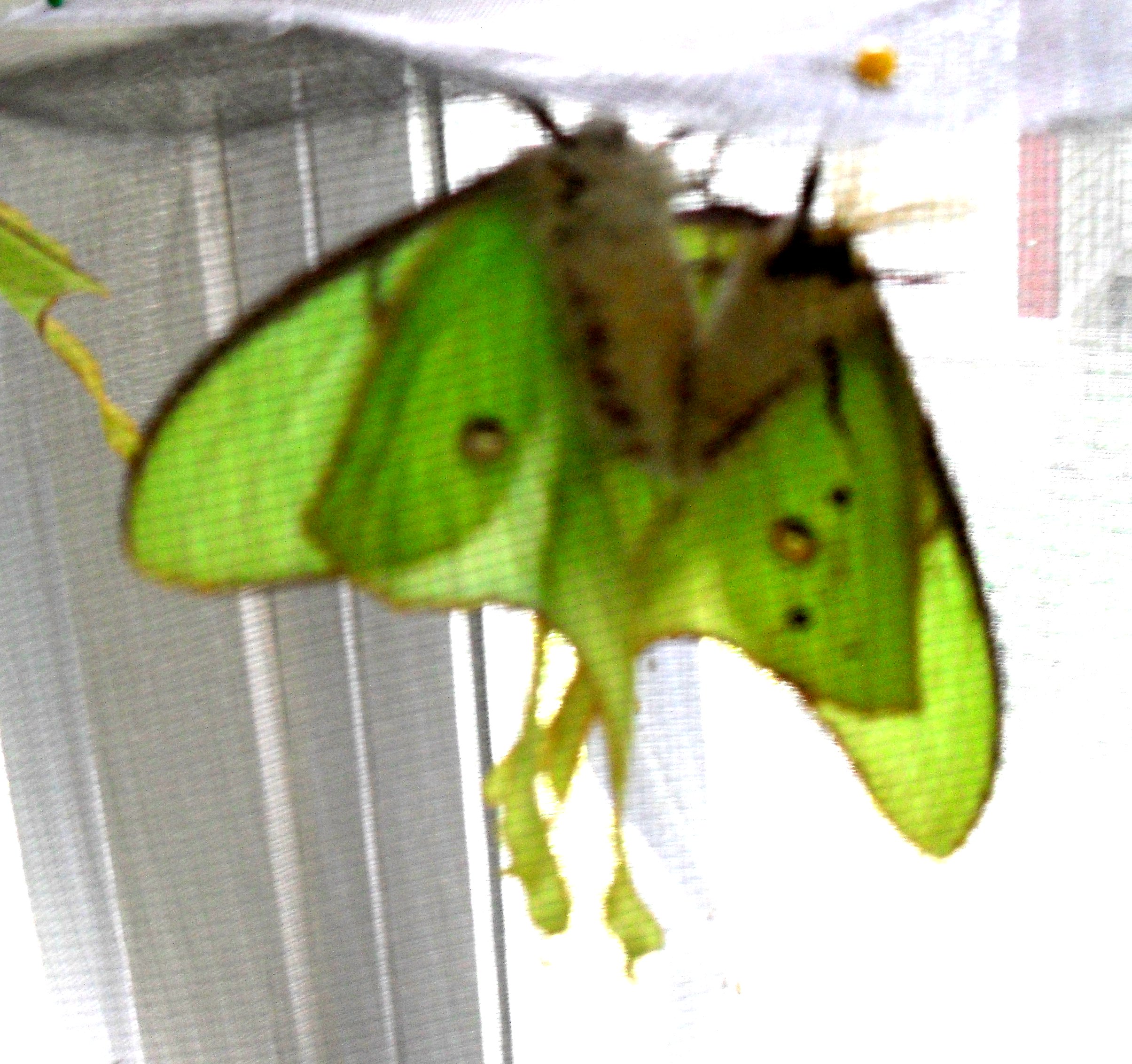

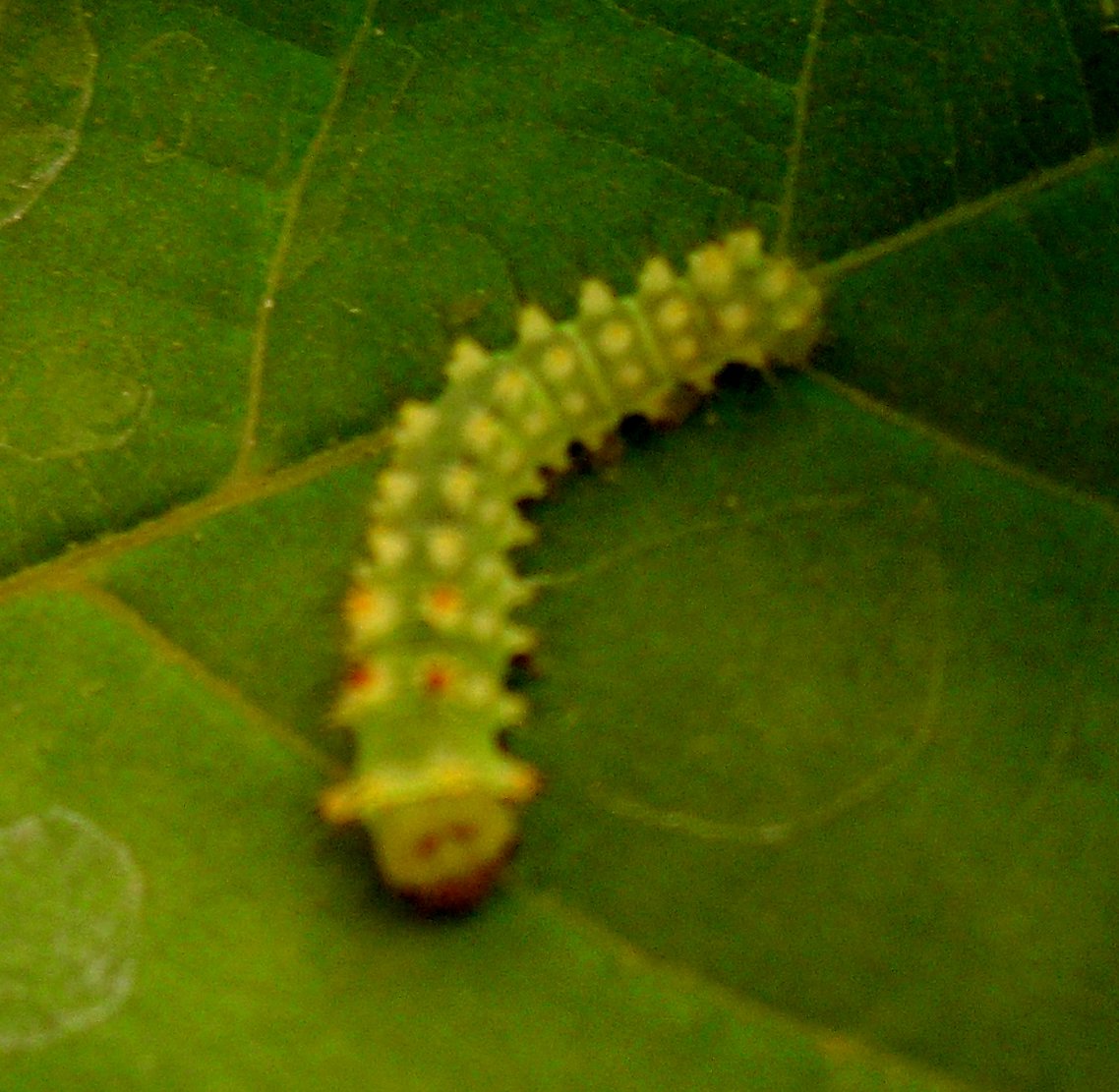
The caterpillars will eat and eat and shed their clothes (body casing) 5 times (5 instars) until they form a cocoon (this particular one didn't get itself covered properly with walnut leaves, so you can see some of the changes it will make until it's ready to hatch), which overwinters somewhere so that it feels the whole winter weather and emerges from the cocoon in late spring/early summer and can repeat this cycle twice in more northerly climes, and maybe three times in the South.
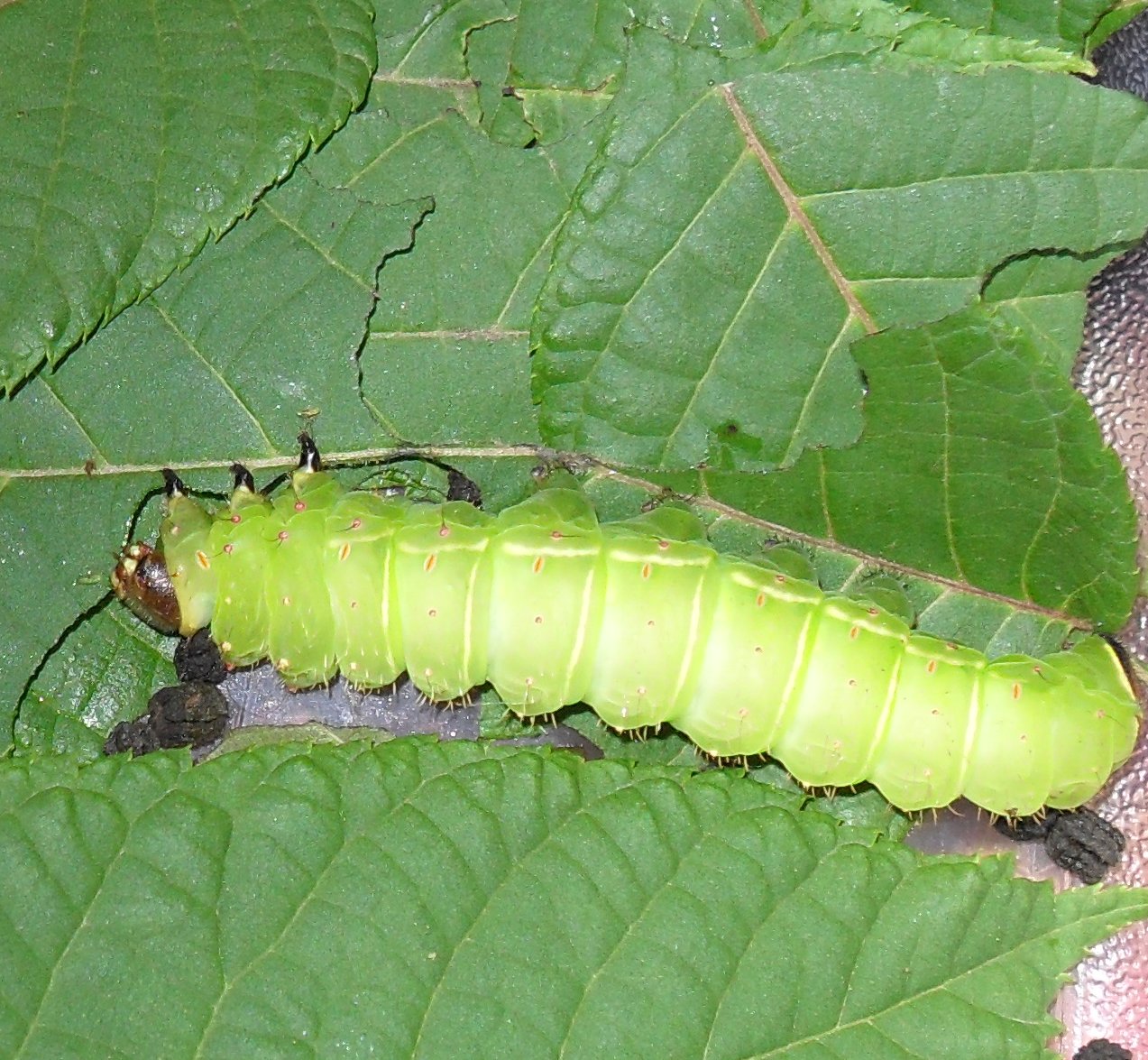
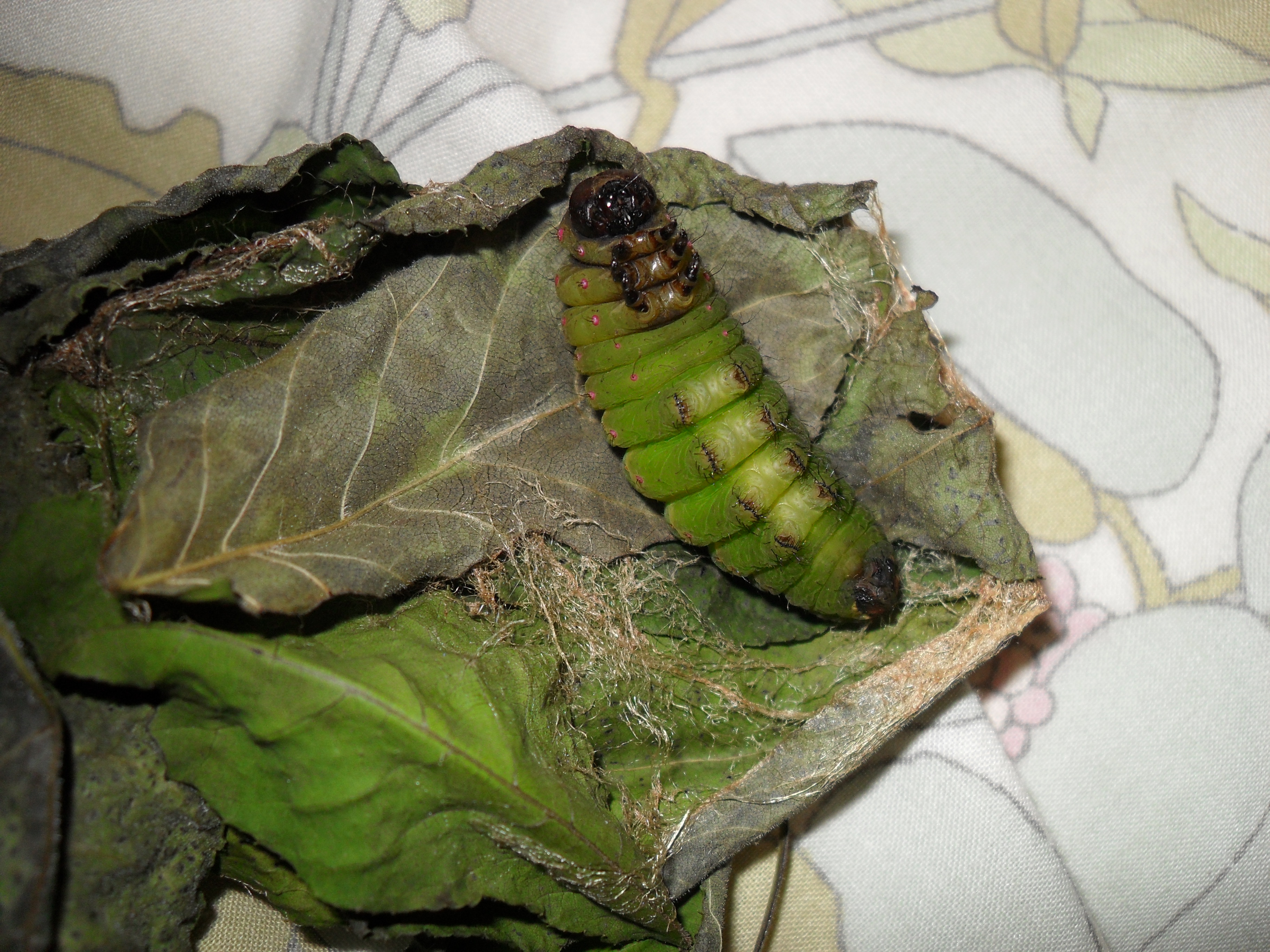
The female ambush bug is able to have her supper (on the huge bee) WHILST mating with the male. For a better picture, here's a male ambush bug that looks like a Senator from Kentucky.
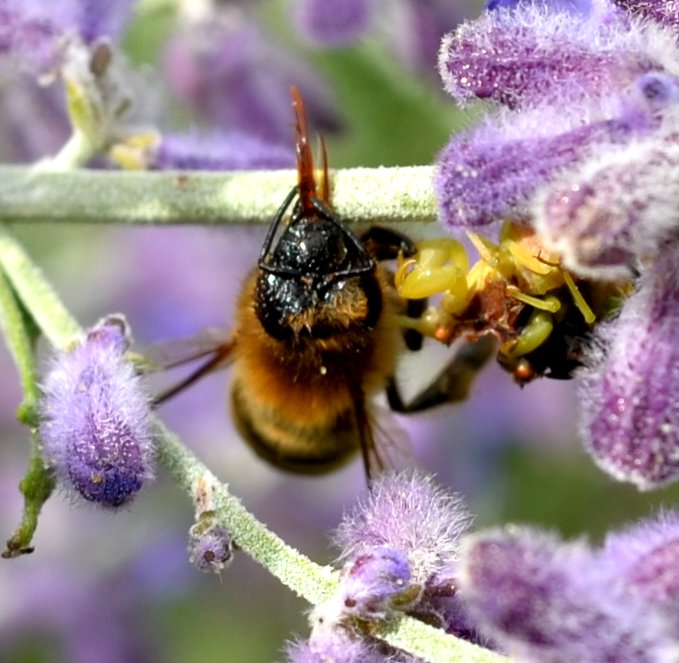
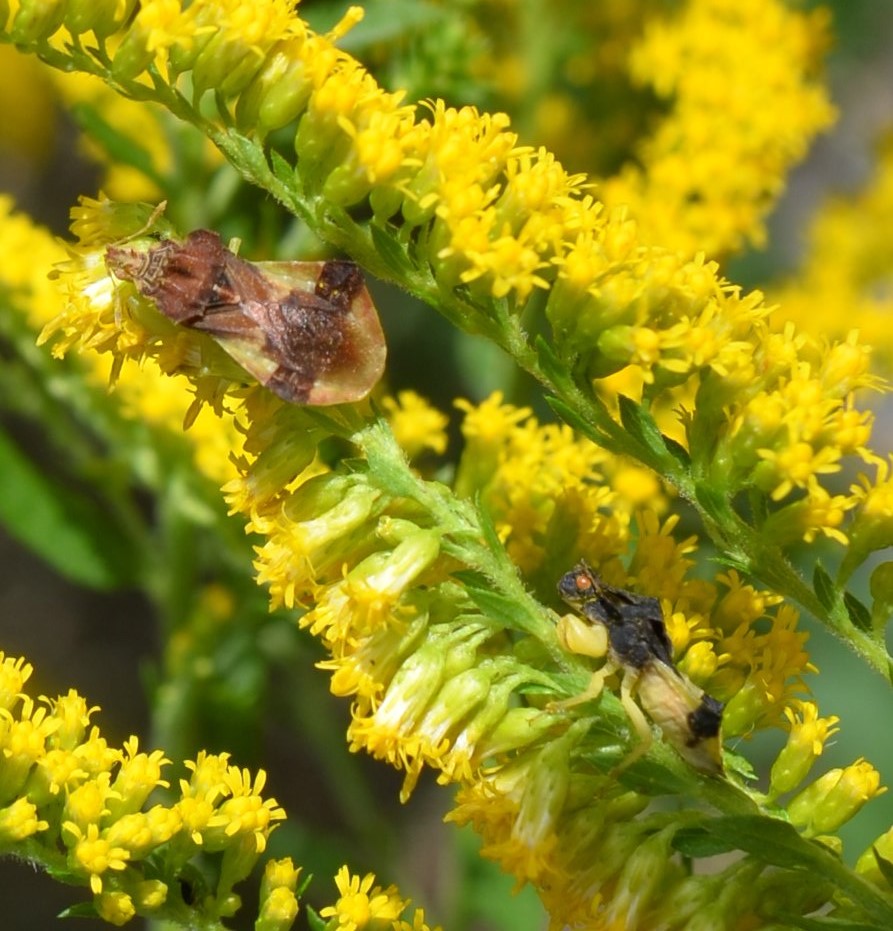
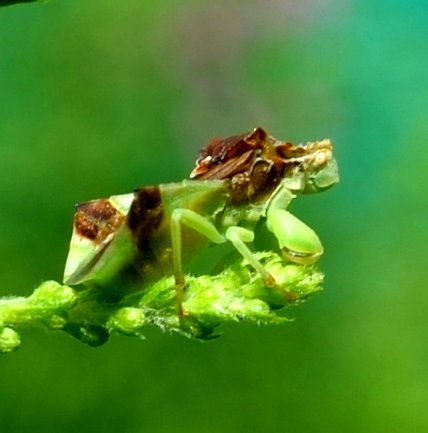
If bees do it, so do the wasps. Here is a pair of so-called Potter Wasps, because their offspring are laid one by one in little pots, much like this one, with some insect or caterpillar food for the gestation period.
Among the bees, wasps and ants (major groups of hymenoptera), there is an interesting set of choices of genders in each group. The social bees and wasps, the ones that live in large colonies, usually come in three genders: the drones or males, whose raison d'etre is to fertilize the eggs laid by the queens. The workers do everything else : usually they are sterile females. Among the honeybees, the queens get extra dollops of "royal jelly", which inspires their DNA to work differently (epigenetics!) and produce fertile females which are probably larger than the other genders, and capable of laying fertilizable eggs. The males do nothing other than to fertilize the queen's eggs. They have to prove their superiority so that the queen chooses their sperm.
The non-social bees, wasps, and ants in general do not have fixed homes, but they may raise their offspring in little single-occupancy clay pots. The paper wasps are especially good examples of the two-sex model. The paper nests are made by the females, and they also lay the eggs in the nests. They have a big party choosing their mates and then get down to the business of raising a new generation of babies. In 2016, a colony of European paper wasp females built their nest inside my third-floor air conditioner. For the summer, they formed a particularly homey exhibit, adding to the nest and laying eggs in the cells of the nest.
They have to scrape pulp from old vegetation, and gather water from the pond to make the paper for the ever-growing nest. Here we see a female of two of the paper wasp species, the northern paper wasp female and when you click on that wasp you get the picture of a different species of paper wasp, this time the European paper wasps. The second composite image shows the caps on the cells containing the young females before they hatch.

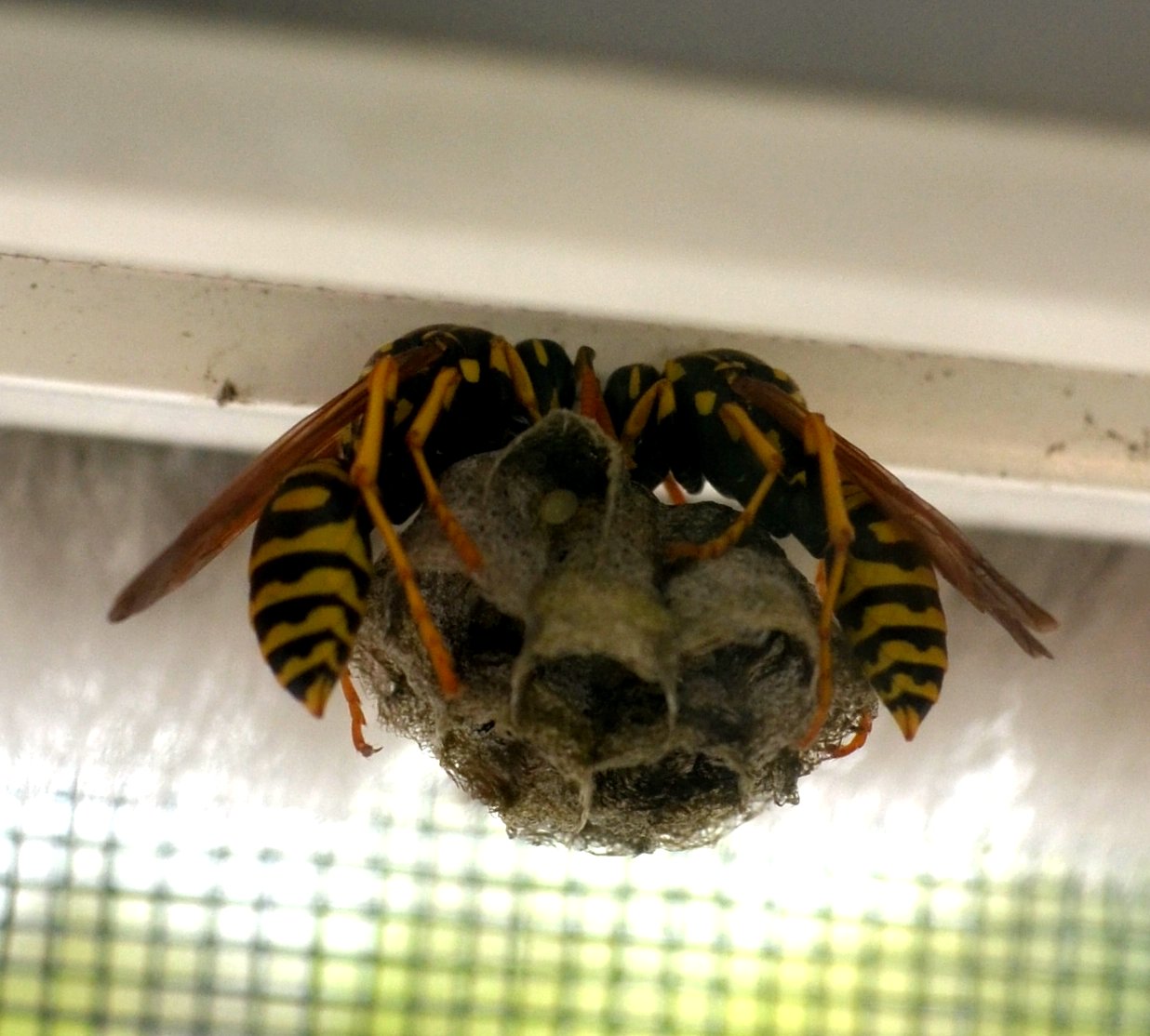

Here is a little bit about reproduction in spiders. The extreme least one should know about spider sex is related to determining the sex of a spider. Both possess palps, tiny little far front legs. Those of the female are quite small slender fake legs that are used by the female in holding prey still during capture and maybe eating too. This first image of, I believe, a young female grass spider shows the palps very clearly. (Click the picture to see a red circle around the palps.) The next image is of a male with round boxing-glove shaped "pedipalps", so called because they are used in making baby spiders. The male uses those pedipalps to soak up semen from where it is made into his pedipalps so that during actual mating all he needs to do is place his pedipalps (one at a time?) into the female's "epigynum", an opening in her underbelly. This makes delivery of semen very neat and means that many males will be able to get outta there before the female feels like a snack. Third: a pair of Common House Spiders mating. The fourth image is of a mother and a father spider who have stuck by her egg case, which is just breaking up into tiny baby spiders (one is already a little more like a little spider than the balls of dough which are the other babies). Really now, if she had eaten him up, would she have this parenting helpmate?
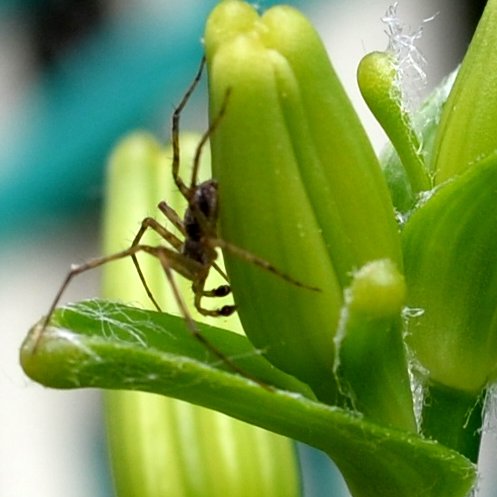
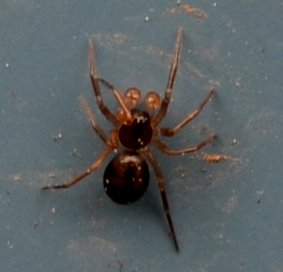
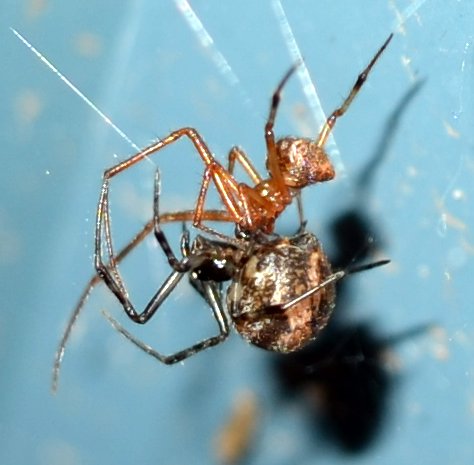

Here are a few more kinds of spider egg hatchings. The first is an unknown spider with his/her hatching baby spiders. The next day, this scene had been replaced with this collection of what seem to be fiber balls, hopefully packed with babies. I've come back and back to this spot and this is the scene on the 20th. The little cases seem to have tiny black wasps coming out of them, much like the little wasps I've seen coming out of infected stink bug eggs. We will have to keep going out there to see if these really are baby spider cases.
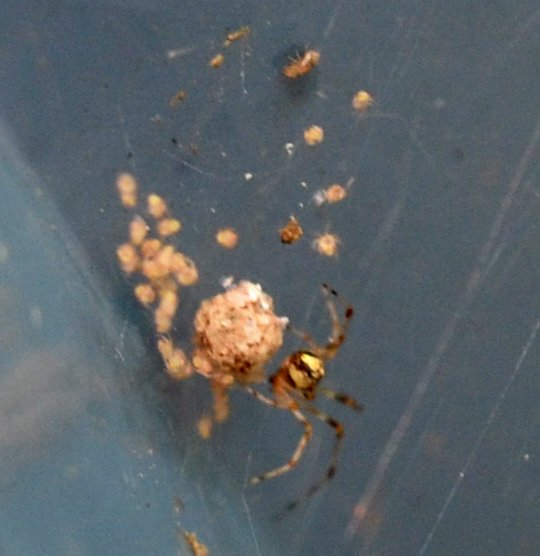

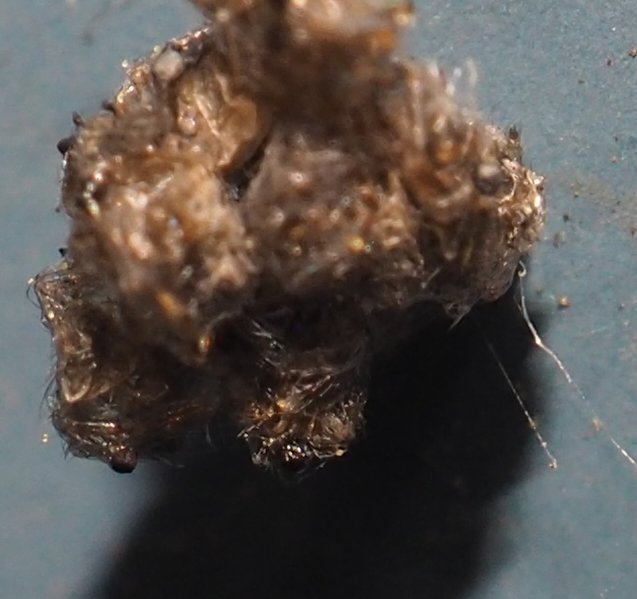


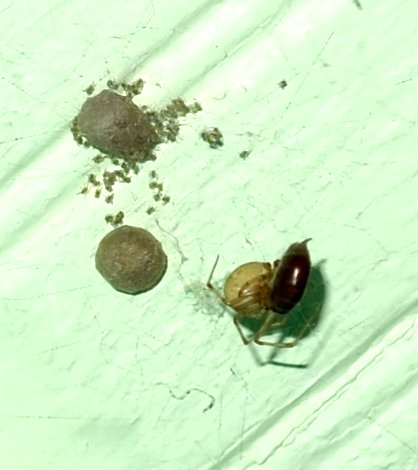
I just wanted to make one point - Naphrys pulex is the name of one of my very favorite jumping spiders. One day I saw a very fat spider and someone on iNaturalist.org told me it looked like a pregnant N. pulex. I really doubted it, because the pattern on the abdomen was stretched almost to the splitting point. A few days later I saw a fat N. pulex but she had lost enough girth that she looked like my old friend. Image 1: non-pregnant N. pulex. image 2: dorsal view: just post-partum. Image 3: lateral view of fat N. pulex just post-partum. Talk about stretch marks!
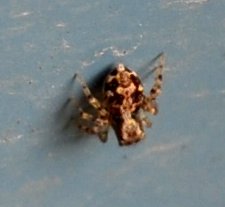
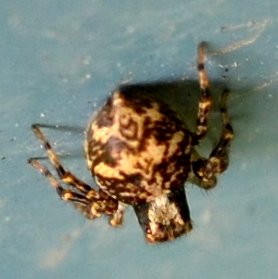

For several years now, the American Toads have come to visit the pond in April or May, then again in June or July.) The males arrive first and later in the afternoon begin tuning their vocal chords, sending out a long trill. Towards evening you can see the females come a-hopping to the pond.
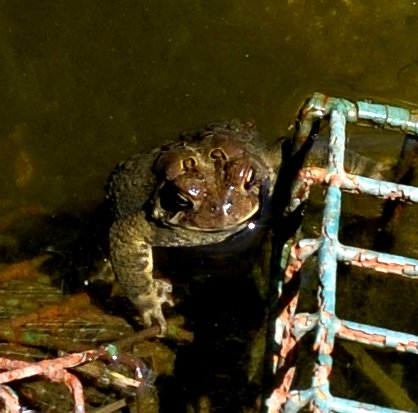
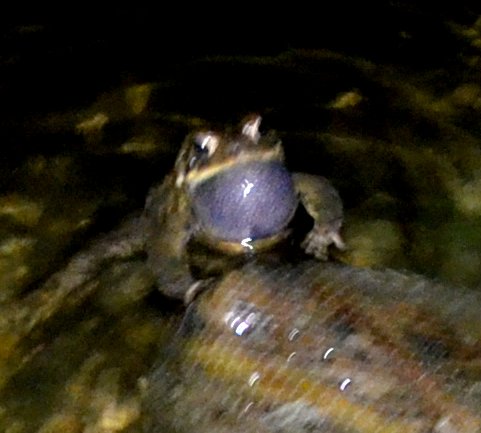
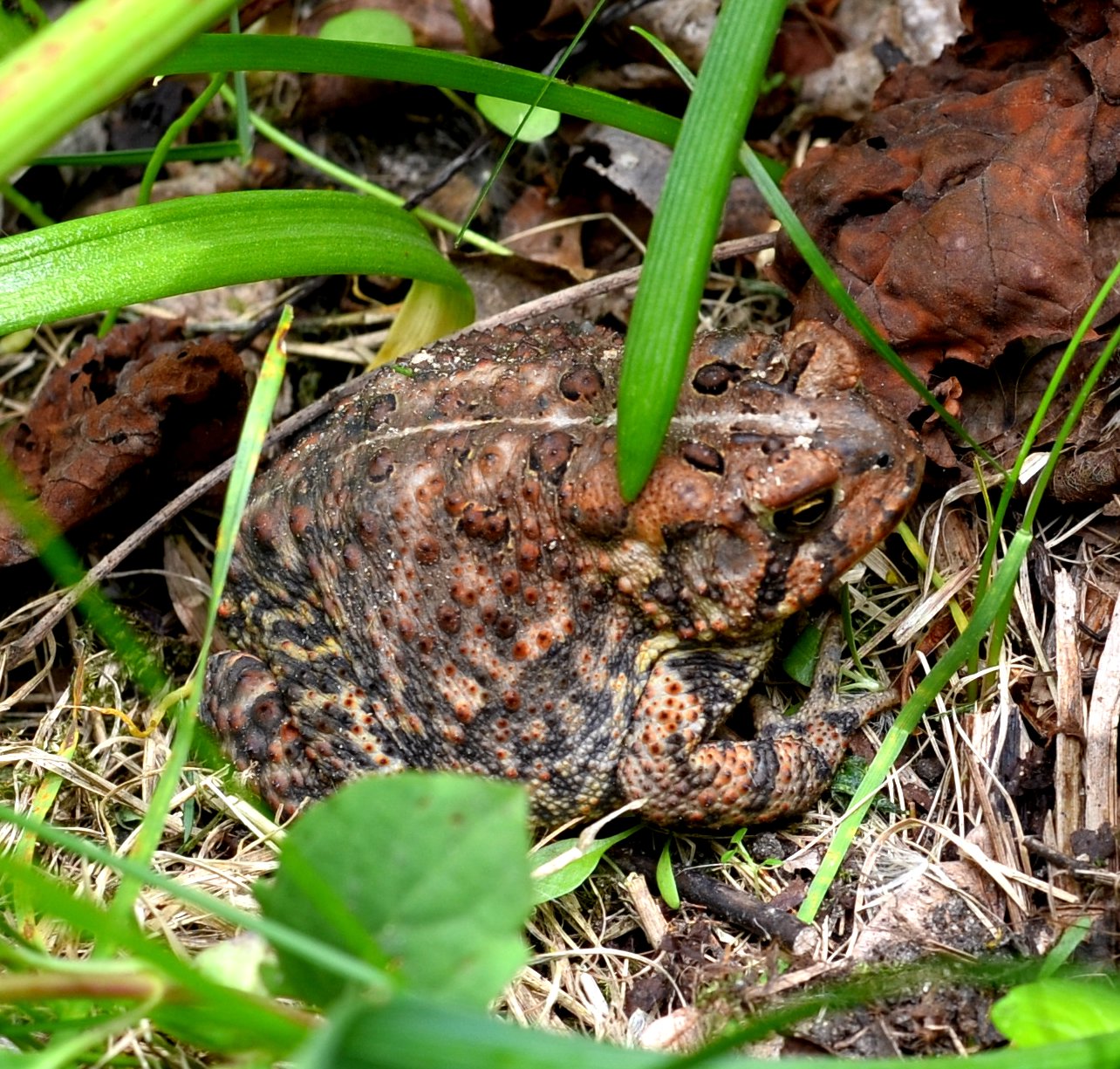
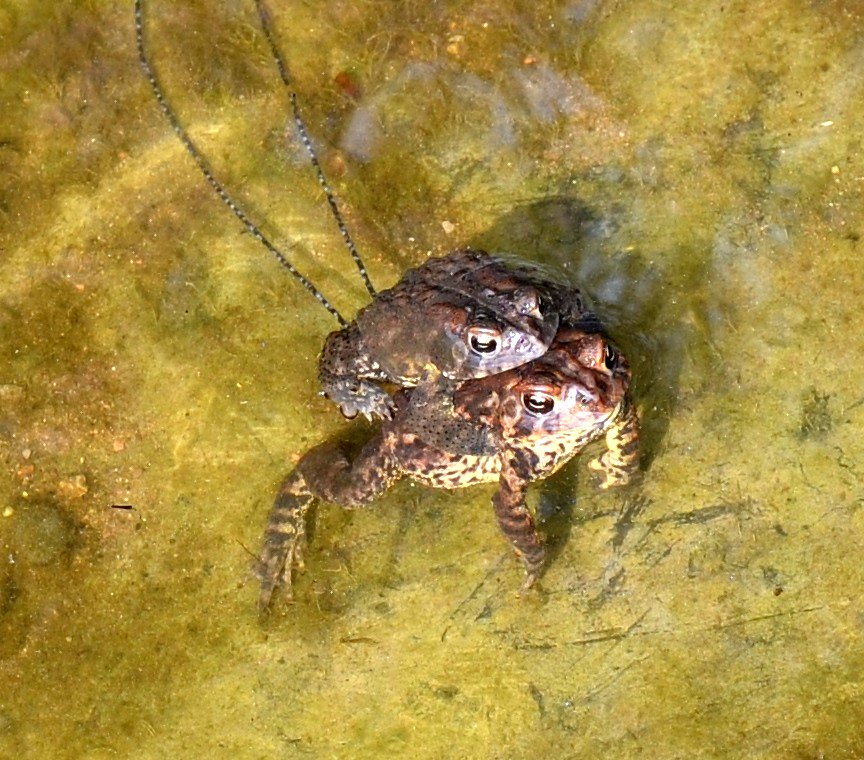
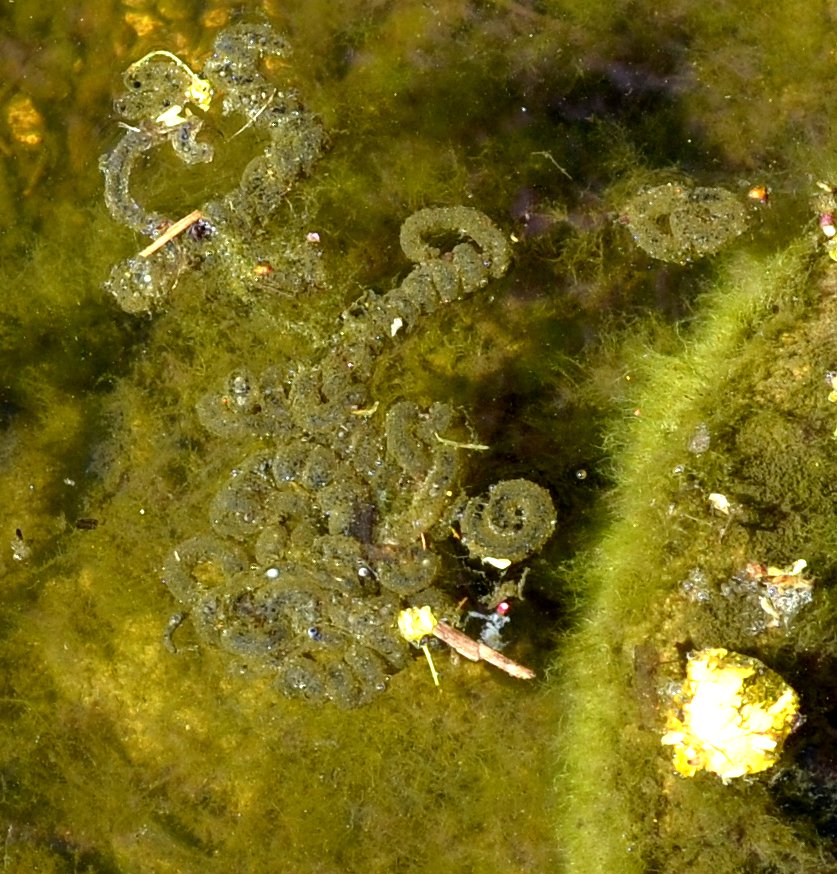
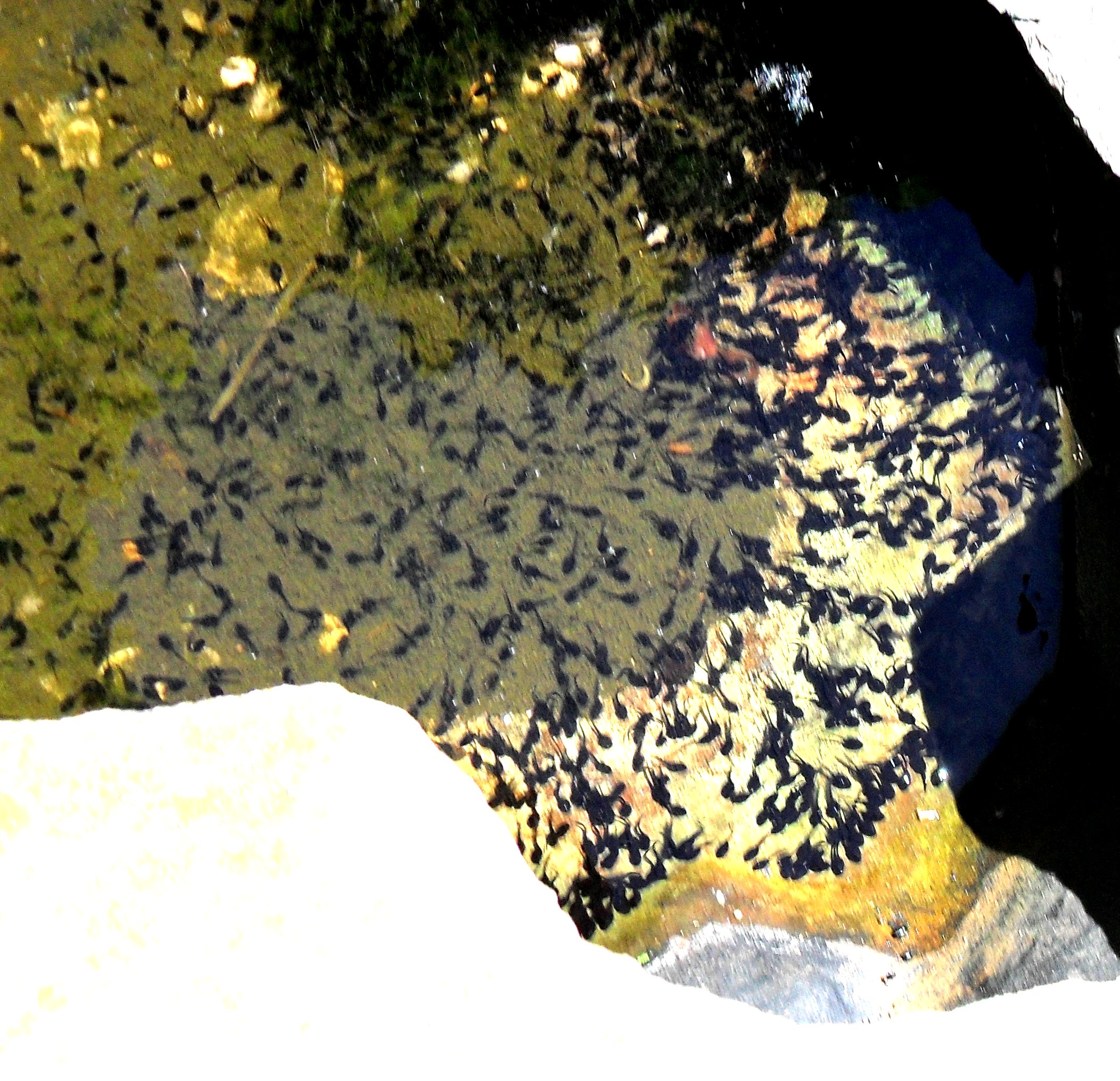
In the usual course of events, the tadpoles grow and begin to resorb their tails and pop out little legs. When the tails are all gone, the tails will be no more, the toadlets will be able to breathe oxygen from the air, and begin to clamber out of the pond and head for some undercover, where they will hide out and grow, living on small insects.
In the spring of 2014, I suddenly noticed a small (about a foot long) northern water snake scarfing my toad tadpoles. Here is the tadpole nursery just before a northern water snake came to call. And here is the snake itself!
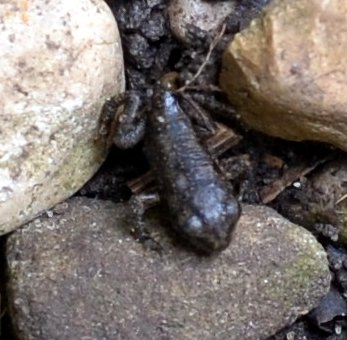

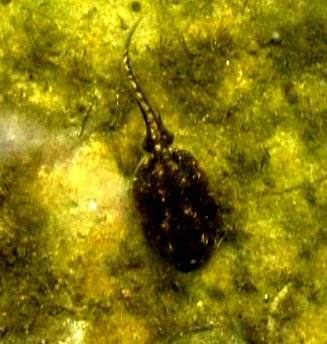
In the spring of 2014, I suddenly noticed a small (about a foot long) northern water snake scarfing my toad tadpoles. Here is the tadpole nursery just before a northern water snake came to call. And here is the snake itself! Since I like my toads intact, I catch the snake (not in my bare hands but with a net and a large carrying container. Snaky is put into a nice clean aquarium in the Nature Center, where he lives for a few years.

We will find that the toads, the baby toadlets and the tadpoles have many natural enemies. Good thing they usually have tons of baby toadlets graduating from toad school. Here is a short article on one night in the back yard with the toads, waiting for one of their bigger enemies.
Toad Vigil
Back to Main Module
copyright Martha O'Kennon 2018


















 and two tiny males 4 10 17 3.jpg)
 and two tiny males 4 10 17 2.jpg)







.jpg)


 and two tiny males 4 10 17 3.jpg)
 and two tiny males 4 10 17 2.jpg)




 and two tiny males 4 10 17 3.jpg)
 and two tiny males 4 10 17 2.jpg)














































